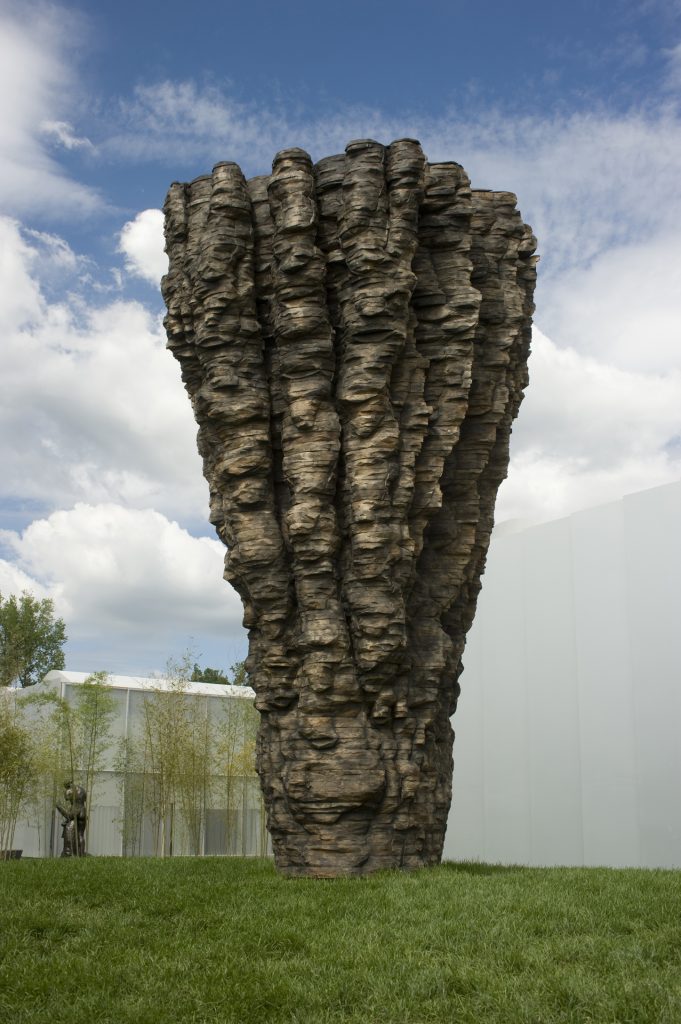Ogromna (obra de arte)
Información sobre la obra de arte
Key Ideas
- This vessel-shaped wood sculpture is made from roughly cut, carefully stacked cedar blocks. A graphite coating gives the sculpture a silvery sheen.
- The title of this work comes from a Polish word that means huge and powerful.
- Ursula von Rydingsvard is a sculptor who creates large sculptural works from cedar and bronze. Her life experience and family history inspired her to use wood as her artistic medium.
- Von Rydingsvard’s artistic process is spontaneous and intuitive. She creates her sculptures based on how she feels in the moment rather than planning them ahead of time.
- This sculpture is an example of public art. The artist created it with the intention of displaying it in a public space.
- This work of art is site specific, or created to exist in a specific location. The artist chose a location where her sculpture would stand out against a neutral background.
Más información
Ogromna is a 20-foot-tall sculpture made from roughly cut cedar blocks that are stacked in layers. The title of the work is a twist on a Polish adjective (ogroman) that describes something huge, monumental, and powerful. The artist says she thinks of this work as feminine, so she added a feminine ending to the title.
Ursula von Rydingsvard is a contemporary sculptor who lives and works in New York City. She creates monumental sculptural works using cedar and bronze. Her large-scale sculptures can be found in public spaces and museums throughout the country. For more than 30 years, she has been creating large wood sculptures intuitively (based on feelings rather than facts or proof) without using any preliminary sketches or models.
Von Rydingsvard was born in Germany. Her parents were Polish and Ukrainian farmers who worked in forced labor under the Nazis during World War II. She grew up in Polish refugee camps in Germany after the war.
My love for wood is part of my history. I come from a long line of Polish peasant farmers, and they were surrounded with wood — wooden homes, wooden fences, domestic implements, wooden tools to farm the land. When you enter any of those houses, you’ll see right outside a huge stack of firewood, usually quite beautifully stacked, with smoothly cut ends.
Ursula von Rydingsvard
Ogromna was commissioned for the NCMA in 2009. To create this sculpture, von Rydingsvard used four-by-four cedar wood beams. She cut, chipped, carved, stacked, and fastened the beams together, transforming machine-cut wood into a giant, handmade vessel-shaped structure. The sculpture’s texture gives it the appearance of something from nature that has eroded over time. The artist applied a graphite coating that makes the surface shine like wet stone. She also added a wood preservative that protects the sculpture. Museum conservators reapply the graphite and preservative to the sculpture as needed.
This is a site-specific work, and von Rydingsvard selected the exact location where she wanted it displayed: on the lawn near the West Building, around the corner from the Rodin Courtyard. The dark wood of her sculpture stands out against the light-colored building behind it.
Choosing the site is always a pivotal part of what the piece needs to be. I wanted to have a neutral background against which my usually dark surfaces can rest, so that the profile can show itself off in a more dramatic way.
Ursula von Rydingsvard
tags: sitio específico, proceso del artista, entorno, investigación, percepción, observación, naturaleza
Recursos adicionales
Recursos para los profesores
- Read a review of an exhibition of von Rydingsvard’s work.
- Watch a short documentary about the artist’s experience creating one of her sculptures.
- Read an interview in which the artist talks about public art.
Recursos para los estudiantes
- View photos of von Rydingsvard at work.
- Lea la biografía del artista.
- Watch a video of the installation of a sculpture by this artist.

